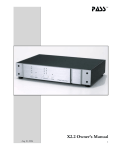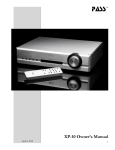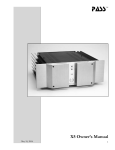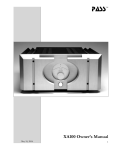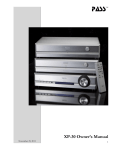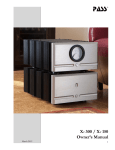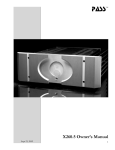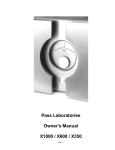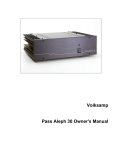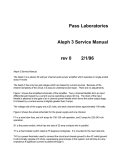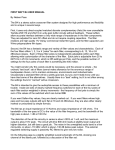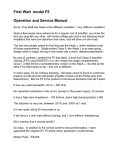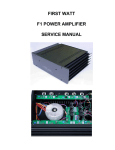Download Pass Labs XP-20 User's Manual
Transcript
pass TM XP-20 Owner’s Manual November 25, 2011 XP-20 Owner’s Manual 1 Introduction The XP-20 is an ultra high quality line-stage audio preamplifier featuring an improved hand held remote control and external power supply electrically isolated from the analog circuits of the preamplifier in a cosmetically matched second chassis. The XP-20 like all Pass Laboratories products attempts to minimize the number of components in the signal path, and yet retain exemplary objective performance specifications. This pre-amplifier pushes the edge of the art by exploring how much subjective quality is obtainable with unique circuit elements applied in innovative ways. The Pass Laboratories XP-20 along with the XP-10 pre-amplifiers are the natural descendants to the highly acclaimed and successful X series of Pass Laboratories line-stages represented by models X0.2, X1 and X2.5. The X series pre-amplifiers have received many highly respected and well-deserved accolades since their introduction in 1997…. justifiably so. More importantly they have provided a solid foundation from which the current and newest product has evolved. These new pre-amp offerings from Pass Laboratories objectively sound and measure significantly better than their immediate predecessors. These are the finest pre-amplifiers Pass Laboratories has built to date, without question! Thank you for your purchase of the XP-20. The new XP series pre-amplifiers are more true to state of the art recordings than our previous product. Given quality recordings, these pre-amplifiers sound more dynamic, bass lines are more clearly, cleanly, and accurately delineated, helping eliminate un-necessary one note bass; instruments and voice are presented in a more refined spatial envelope, and with better spectral balance. Fine nuances and details, which frequently go un-noticed, now become apparent -even in loud and highly complex musical passages. The simple truth is that a decade of knowledge and experience gained, coupled with new component technology, has enabled both enhanced performance and listening satisfaction over the building blocks we had available when the original X series pre-amplifiers came to market. Pass Laboratories has not been shy about taking advantage of these circuit innovations and new components in these new pre-amplifiers. You will hear, and appreciate, these significant sonic improvements in the XP series product. Collectively, audiophiles tend to listen quite a bit differently today, XP-20 Owner’s Manual 2 than they did when the original X preamps were created, and the XP line of product have all been designed to reflect those changes in listening style. Pass Laboratories has redesigned the remote control to allow direct access to the most frequently wanted control functions, thus simplifying and enhancing product operation. The new remote control codes have been carefully selected to minimize the impact on other remote controlled electronic devices, allowing for more carefree product placement. Volume control steps on the new preamplifiers are more numerous and generally of smaller increments, giving the listener a wider choice of listening levels to better accommodate the wildly-fluctuating signal levels of current, verses legacy, recordings. Changing lifestyles dictate that many audiophiles now share family space where music may be an adjunct to other activities. To better serve the needs of these listeners, the newest Pass Laboratories pre-amplifiers allow for significantly more precise volume steps and greater attenuation at the very lowest volume levels. So that these very low-volume listening levels have real world practicality, the noise floor and very fine detail retrieval of these new pre-amplifiers is dramatically superior to our previous product. Frequently, the perception of increased detail comes at the cost of equally increased grain or edginess in the music. With this new preamplifier, hundreds of hours of thoughtful listening and careful adjusting have produced a product where the enhanced detail simply comes through as greater spatial refinement and dynamic accuracy; without any loss of musicality. Bass definition is better than in pervious models, highly dynamic passages typically have more weight, a more accurate leading edge with increased control and the spectral balance is more finely integrated top to bottom. As good as the XP-10 is, the XP-20 performance metrics are enhanced over those available in the XP-10 by virtue of a separate and additionally regulated power supply. For the listener these circuit enhancements will convey musical bass with significantly more impact, articulation and timber accuracy. With well-recorded material the XP-20 will present a more refined sound stage than the XP-10 with greater ability to accurately delineate instruments in their proper spatial perspective of depth, width and height. XP-20 Owner’s Manual 3 We sincerely believe these are simply the best sounding pre-amplifiers Pass Laboratories has ever built! Simply put the XP products deliver the experience of a past musical event in a more believable sonic panorama than anything we have previously brought to market. Thank you for listening and giving us the opportunity to prove this claim. Advisory There is an Extremely Small (but Non-zero) Chance That, Through a Process Know as Tunneling, This Product May Spontaneously Disappear from Its Present Location and Reappear at Any Random Place within the Universe, Including Your Neighbor’s Domicile. The Manufacturer Will Not Be Responsible for Any Damages, Inconvenience or Mental Anguish That May Result. There is a much higher probability that when you first plug your new pre-amps power supply into the wall and listen to your favorite selections that you will not be experiencing the full measure of performance this product is capable of. These are high bias Class A topology circuits and their performance is largely temperature dependent. We expect these circuits to heat up slowly through normal operation, do not attempt to augment that heating by any artificial means. Temperature and performance will slowly stabalize over the first 24 48 hours of operation and thereafter be at their sonic best. Be aware however that if you unplug or otherwise remove power from the unit that the warm up period starts afresh. Please give this product at least 24 hours initial warm up time before attempting any critical listening. A typical current draw for this product is 25 watts or less; the XP20’s are designed to be powered up 100% of the time. Set-up So much for the philosophy, physics and advantages, lets play music. Please read and understand the operational instructions and safety issues associated with this product. We go through great effort to make a soundly engineered, and supurbly performing rugged product of lasting duribility. We understand that things infrequently go wrong, if you have any questions or problems please contact either your dealer or the factory, we are here to support the product and you, the user. XP-20 Owner’s Manual 4 As with all audio electronics the power cable should be the last thing attached and the first one removed any time you hook up or remove equipment from the signal chain. The DIN-25 umbilical cable should never be connected or removed with the power supply chassis plugged into house power. The preamplifier has five sets of stereo input connections, both single-ended and balanced output connections and a full function remote control in addition to the normal complement of front panel control functions. The preamplifier’s voltage and current rating are indicated by affixed tag on the rear of the preamplifier’s separate power supply. It will indicate 240 volts, 220 volts, 120 volts, or 100 volts. A 1.0 amp 3AG slow blow fuse is provided with 100-120 volt units, and a 0.50 amp slow blow fuse is provided with 220-240 volt units. The input frequency rating of the power supply is 50 to 60 Hz. The preamplifier typically draws approximately 25 watts of power from the utility mains during operation. Please verify that the indicated voltage requirement of this preamplifier’s power supply is consistent with the utility voltage at your location. We have provided a standard IEC AC power cord that fits into the IEC 320 line receptacle at the rear of the power supply chassis. The preamplifier and power supply is equipped for operation with an earth ground provided by the users AC outlet. Do not defeat this safety ground. The chassis and circuit ground of the preamplifier is connected to earth through a power thermistor, which gives a ground connection for safety but helps avoid ground loop related noise issues. Please connect the power supply to the preamplifier chassis by the supplied umbilical before plugging the power supply into the wall. Conversely please unplug the power supply from the wall before disconnecting the umbilical cable. In’s and Out’s There are a total of five inputs. Two of the five inputs are balanced XLR only. The other three inputs are single-ended only. The XP-20 also has a “Tape Loop” with single ended inputs and outputs. There are three pairs of outputs available with identical gain structure. One pair Balanced, two pairs single-ended. You may use more than one output at a time. The single ended outputs are paralleled, but under most circumstances will drive several devices at once, with no anticipated ill effects by virtue of the XP-20’s low output impedance and high current capability. The balanced outputs are derived from their own XP-20 Owner’s Manual 5 circuit elements, independent of the single ended outputs. Tape input communicates back to the input bus, independent of the XP20 volume control. Balanced inputs and outputs are via XLR connectors. Singleended inputs and outputs are via RCA connectors. On the XLR connectors, pin 1 is grounded, pin 2 is the positive signal, and pin 3 is the negative signal. Left channel RCA connectors are marked with “L”. Right channel RCA connectors are marked with “R”. In a similar fashion balanced XLR inputs and outputs are marked with “L” for left and “R” for right channel. The main outputs are located at the left-hand side (viewed from the rear) of the rear panel, two male XLR connectors, and four RCA connectors, “R” (right) and “L” (left). The RCA connector’s ground (shell) is in parallel with pin 1 of the XLR outputs and the RCA hot is fed from an independent summing junction that maximizes the X circuit benefits. The RCA, single-ended, outputs are buffered from the balanced outputs. You may use both the single ended and balanced outputs at the same time. On the XLR, pin 1 is ground, pin 2 is positive, and pin 3 is negative. The XP-20 has an onboard tape loop for those of you who like to record, add a signal processor into the chain or simply need one additional pair of RCA inputs to complete your music system. The tape loop is available only from the remote control and is selected or deselected by a single keystroke of the “Tape” button on the remote. When you select Tape from the remote the display shows a lower case letter “t” on the right hand side. When the letter “t” is showing tape input is selected and other inputs are de-selected, regardless of other settings you may have chosen. Input and output connectors were carefully selected to withstand a lifetime of frequent use. Handy Features The XP-20 gain chassis has a single pair of binding posts labeled “Ext. Amp Turn-on”. A 12-volt signal is available at these binding posts to control additional entertainment electronics. This External Turn On feature was specifically intended to control Pass Laboratories power amplifiers but may in fact control competitive product with similar features. Check your power amplifiers owner manual and specifications for particulars. This function is only active from the hand held remote control. XP-20 Owner’s Manual 6 Description of Operation In application the XP-20s front panel controls and alphanumeric display are quite straight forward, and intuitive. We encourage you to become familiar with their operation prior to establishing any input connections with this unit. Experience indicates that engaging in a few minutes of exploration will add much to your ultimate enjoyment of this exceptional Pass Labs product. The left most button on the front panel is Mute. Pressing this button toggles between mute on and mute off. Mute on removes signal from the output of the preamp. The second button from the left is Mode. The front panel mode switch cycles the preamplifier control chassis display through 3 different levels of illumination, Bright, Dim and Off. Default setting is Bright. Manually selection of illumination levels overwrites the default setting. Removing power re-boots the system and re-establishes the default settings. When in Off the display will illuminate at the Dim level only as control selections are being made. Six seconds after the last control command the display will blank, returning to Off. The two input elect switches (designated by left and right pointing arrows) toggle through inputs 1-5 in sequence. When selecting an active input, as previously indicated, the left and right arrows select for inputs 1 through 5. Input 5 is unique in that it is linked with the PASS THRU (Home Theatre) function. (The HOME THEATRE / PASS THRU FUNCTION is discussed at length below.) Before selecting the theatre pass through (pass thru) option, it is imperative that the input device on input number 5 has its gain set to minimum. Failure to follow this precaution could result in a volume level intolerable to both ears and speakers. (The standard 2 volt source component, with the pre-amp set to 0 dB, will drive most power amps to full rated output.) As an added precaution when “pass through” is selected the volume ramps upto 75. This is to prevent nasty surprises when “pass thru” is selected accidentally. The ramp up sequence can be stopped at any time by hitting any button on the remote. The theater “Pass Thru” function bears special attention, this function is only available as direct access through the hand held remote control. This function is associated only with input number 5 and has two positions selected with the “pass thru” button on the XP-20 Owner’s Manual 7 remote; those two positions, on and off. This function is useful in that it allows the preamplifier to function as a unity buffer (0dB gain at volume step 75) for use with components that best function with their own volume controls, such as surround processors. When the right-front and left-front outputs of the processor are routed through input 5 of the XP-20 (with the gain of the XP-20 set for step 75), the volume will be under full control of the processor and the XP-20’s action will be totally transparent. When the user chooses this setting the software sets the XP-20’s gain to step 75 and displays the setting as 75P for both right and left channel, regardless of how it was previously configured. When at unity gain in the home theater mode (Pass Thru) both left and right level controls on the XP-20 will have a displayed value of 75P (0 dB), and any previous balance settings will be over written, allowing total control by the processor. Both of these default conditions are intentional, and intended to make the most advantageous use of your source electronics. You may also set any input to unity (0 dB) by setting the volume at step 75 from the remote or front panel control. When “Pass Thru” is de-selected the XP-20 reverts back to the previous input, volume and balance settings. Input 5 may be manually selected and used without the “pass thru” function, in which case its behavior will be identical to inputs 1-4. The electronic volume control allows greater than 80 dB range and is driven by a micro-controller that reads the optical encoder serving as a front panel volume control. In this manner tracking of the volume of the two balanced channels is possible with accuracy unavailable on any ordinary analog volume control, assuring precise level steps and high common mode noise rejection in balanced circuits. Wayne Colburn’s exceptional volume control in conjunction with the fluorescent display give the user ability to replicate volume levels with absolute accuracy in steps of roughly 1 dB or less. The remote control uses a multi-button direct access architecture. This remote is designed to operate several pieces of Pass Labs electronics, not all of the functions available on this remote will be applicable to all of your Pass Laboratories electronics. Specifically the uppermost left hand button marked “power” does not work with the XP-20. The XP-20 is designed to be powered continuously and therefore this button will not affect the pre amplifiers operation. XP-20 Owner’s Manual 8 The Remote control operation is, or should be very intuitive in operation; we have attempted to make its operation as familiar as possible. Where applicable the remote mirrors the front panel controls. POWER: As previously mentioned has no reality with the XP-20. This specific control functions has no effect on this product. EXTERNAL AMP ON: The “external amp on” button supplies a 12-volt trigger voltage from the rear panel of the XP-20, which will control various pieces of auxiliary equipment. This function is intended to control Pass Laboratories power amplifiers. For specifics please see the instructions that accompany your power-amplifier. You may also call the Pass Laboratories factory for specifics. MUTE: pressing mute once will quiet the pre-amplifier outputs; pressing mute a second time will return you to the previous volume control setting. INPUT SELECTION: Pressing. 1,2,3,4,5 will immediately move the input selection to that input selection; volume and balance settings will not be disturbed. BALANCE: Pressing balance left (<) or balance right (>) will increase the level in the left or right speaker, depending upon which button is pushed. VOLUME: Pressing the increase (^) button or the decrease (v) button will shift the volume setting 1dB, holding a button down will increase or decrease the level until such time as you either release pressure on the button or reach the limits of the volume control. PASS THRU: Pushing this button twice, sets the pre-amplifier to volume step 75 (0 dB) and input 5. As an added precaution when “pass through” is selected the volume ramps upto 75. This is to prevent nasty surprises when “pass thru” is selected accidentally. The ramp up sequence can be stopped at any time by hitting any button on the remote. The button must be pressed again to exit “Pass Thru” and unlock the other command selections. TAPE: Pushing this button once selects the single ended “Tape” as your sixth input, pressing a second time deselects the tape input and defaults back to the indicated input. When “Tape” is selected a lower case letter “t” will appear on the right hand side of the display. XP-20 Owner’s Manual 9 DISPLAY: The default setting for the display is “bright”, pressing the “DISPLAY” button once changes the display to it’s “dim” or “low intensity” setting, pressing the button a second time selects “off ” for the display. When “off ” is selected any other control function will cause the display to indicate product operational status for approximately 7 seconds and then the display will once again blank. Pressing the “DISPLAY” button a third time cycles back to a “bright display”. We recommend the use of the balanced output mode where possible. Balanced input to power-amplifiers will typically retain the character of the input mode, but offers less distortion, less noise, more gain, and more voltage swing, without compromising the sound. With balanced operation, the common mode rejection of the preamp reflects the intrinsic common mode rejection of the topology, the matching of the gain devices, and the matching of the attenuator channels. In this case we have been able to keep the total mismatch to about .1%, for a common mode rejection of approximately -60 dB. The input system of the preamplifier will exhibit full common mode noise rejection with passive balanced sources, where the negative input is connected to ground at the source through the appropriate source impedance. This allows adaptation of unbalanced sources to balanced operation with passive cable connections in a manner that achieves the superior noise rejection of active balanced sources. The use of a micro-controller allows all of the preamplifier functions to be repeatable and accurately controlled. The microprocessor only controls the functions of the preamplifier. At no time does any of the input or output signal come into contact with the digital control signals. The digital circuits are powered by a power supply that is isolated from the analog supply. Should it ever be necessary to update the software that controls the functioning of the preamp only the socketed micro-processor need be changed. Rugged mechanical muting relays, which delay connection during turn-on and shut off the output when insufficient power supply is available to maintain regulation, guard the output of the preamplifier and offer protection to the power-amplifier and loudspeakers. The XP-20 consists of two chassis, shipped in a single box. XP-20 Owner’s Manual 10 “Pass”, “pass”, “Pass Labs”, “Pass Laboratories”, Supersymmetery”, “Aleph”, and “Zen” and are all registered trademarks of Pass Laboratories, Inc., and all rights thereto are protected by law. XP-20 Owner’s Manual 11 For your protection please read the following: Water and moisture: Electrical devices should not be used near water ( as per example, near a bathtub, washbasin, kitchen sink, laundry tub, wet basement or swimming pool ). Care should be taken such that objects do not have the opportunity to fall, and that liquid is never spilled onto or into the device enclosure through openings. Power Sources: An electrical device must be connected to a mains power source in strict accordance with the supplied product owner’s manual. Please verify that the AC mains voltage specified in the product manual matches those requirements indicated on the unit and the AC voltage provided to your location by the power company. Grounding: Adequate precautions should be taken so that the grounding provisions built into an electrical product are never defeated. Power Cords: Pass Laboratories provides a power supply cord that meets all legislated requirements for the market in which the product was originally sold. If you choose to substitute an after-market product we urge you to choose one that is fully safety rated by the necessary local authority. Power Cord Protection: Power supply cords should be routed so that they are not likely to be walked on, abraded, or pinched by items placed on or against them, paying particular attention to cords where they enter plugs or exit from a device. Never under any circumstance insert a cut or damaged power cord into a mains power socket. Power and Signal: Cables should never be connected / disconnected with equipment powered up. Failure to heed this warning may damage or destroy equipment. Ventilation: Power-amplifiers run hot, but you should be able to place your hands on them without discomfort. You must allow for this heat in installation, by providing for free air circulation around the product. Electronics should not be subjected to sources of excessive radiant heat. Excessive heat can shorten the life of the product and may cause the electronics to self-protect and shut down. Servicing: To reduce the risk of fire, electrical shock or other injuries, the user should not attempt to service the device beyond that which is described in the operating instructions. All other servicing must be referred to qualified service personnel. XP-20 Owner’s Manual 12 Pass Labs Warranty All Pass Laboratories products purchased new from an authorized Pass Laboratories dealer in North America are covered by a transferable, limited 3-year warranty. This warranty includes all parts and labor charges incurred at the factory or factory specified repair facility, exclusive of any subsequent or consequential damages. Damage due to physical abuse is specifically excluded under this warranty. For this warranty to apply the customer is responsible for returning the product unmodified to the factory within the specified warranty period. The customer assumes all responsibility for shipping and insurance to and from the factory or a factory specified repair facility. The conditions and stipulations of this Pass Laboratories warranty only applies to units originally sold new through an authorized dealer. Warranty on factory repair is 60 days and covers only the scope of the original repair. Non-North America customers should consult with their original Pass Labs dealer or distributor for warranty repair instruction prior to contacting the factory or shipping product to the factory for repair. Non-North American product must be returned to the country of origin for warranty service. Foreign distributors are only required to offer warranty service on Pass Laboratories product that they have imported, verifiable by serial number. Please note: Conditions of warranty service and customer rights for product purchased outside the United States may vary depending upon the distributor and local laws. Please check with your local distributor for specific rights and details. Any modifications to Pass Laboratories products that have not received written factory approval nullify all claims and void all provisions of the warranty and liability by the maker or authorized distributor. Should a modified product be returned to the factory for repair the owner will be required to pay all necessary charges for the repair in addition to those charges required to return the product to it’s original configuration. In the case of safety issues, no product shall be returned to the customer without those safety issues being corrected to the most recent accepted standards. Removal or alteration of original Pass Labs serial numbers voids the factory warranty. Product with altered or missing serial numbers will be suspect as counterfeit or stolen product. Pass Laboratories will not repair or in any way indemnify any counterfeit or cloned product. Pass Laboratories does not offer products in voltages intended for international markets either to authorized Pass Labs dealers or to third parties located in the United States or Canada. For more information please contact: Pass Laboratories Inc. XP-20 Owner’s Manual 13 pass® Pass Laboratories Inc. PO Box 219, Foresthill, CA 95631 voice: 530.367.3690 - fax: 530-367-2193 - web: passlabs.com XP-20 Owner’s Manual 14














